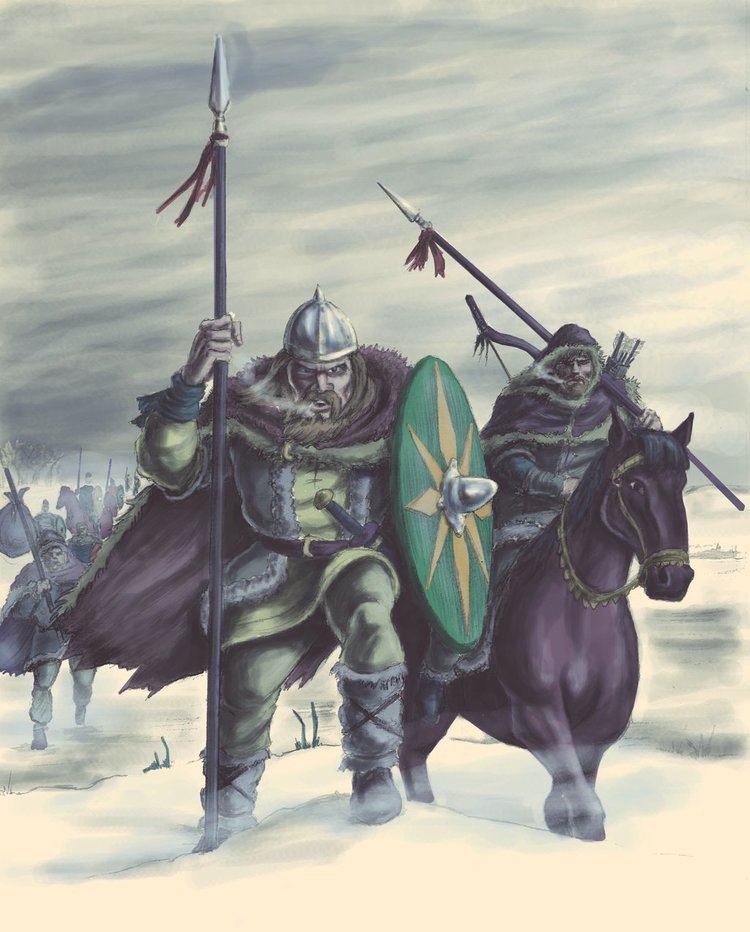Start date December 31, 406 AD | ||
 | ||
Similar Operation Plunder, Sack of Rome, Battle of the Catalauni, Operation Varsity, Battle of Adrianople | ||
31 December 406 is the often-repeated date of the crossing of the Rhine by a mixed group of barbarians that included Vandals, Alans and Suebi. The Rhine-crossing transgressed one of the Late Roman Empire's most secure limites or boundaries, and so was a climactic moment in the decline of the Empire. It initiated a wave of destruction of Roman cities and the collapse of Roman civic order in northern Gaul. That, in turn, occasioned the rise of three usurpers in succession in the province of Britannia. Therefore, the crossing of the Rhine is a marker date in the Migration Period, during which various Germanic tribes moved westward and southward, out of southern Scandinavia and northern Germania.
The full statement of received opinion has been that a mixed band of Vandals, Alans and Suebi crossed the Rhine at Mainz on December 31, 406, and began to ravage Gaul. Several written accounts document the crossing, supplemented by the time line of Prosper of Aquitaine, which gives a firm date of 31 December 406.
A letter by Jerome, written from Bethlehem, gives a long list of the barbarian tribes involved (Quadi, Vandals, Sarmatians, Alans, Gepids, Herules, Saxons, Burgundians, Alemanni and the armies of the Pannonians). Some of them, like Quadi and Sarmatians, are drawn from history or literary tradition. Jerome mentions Mainz first in a list of the cities devastated by the incursion, which is the sole support for the common assumption that the crossing of the unbridged Rhine was effected at Mainz. Jerome lists the cities now known as Mainz, Worms, Rheims, Amiens, Arras, Thérouanne, Tournai, Speyer and Strasbourg as having been pillaged.
The initial gathering of barbarians on the east bank of the Rhine has been interpreted as a banding of refugees from the Huns or the remnants of Radagaisus' defeated Goths, without direct evidence. A frozen Rhine, making the crossing easier, is not attested by any contemporary, but was a plausible surmise made by Edward Gibbon. On the east bank, the mixed band of Vandals and Alans fought a raiding party of Franks. The Vandal king Godigisel was killed, but the Alans came to the rescue of the Vandals, and once on the Roman side, they met with no organized resistance. Stilicho had depleted the garrisons in 402 to face Alaric in Italy.
Zosimus' New History (vi.3.1) imputes the usurpation of Marcus in Britannia to a reaction to the presence of barbarians in Gaul in 406; from a fragment of Olympiodorus, the acclamation as Emperor of Marcus, the first of the Romano-Britannic usurpers, took place that same summer.
Uncertainty over date
An article by Michael Kulikowski, finding that "the sequence of events bristles with technical difficulties", bypassed modern historians' accounts, which he found depended upon Edward Gibbon and one another, to reanalyse the literary sources; his conclusion was that a date for the mid-winter crossing of the Rhine of 31 December 405 offers a more coherent chronology of events in Belgica, Gaul and Britannia. Kulikowski outlined how the year 406 came to be selected.
The date 31 December 406 is firmly offered by Prosper of Aquitaine in his year-by-year chronicle: "In the sixth consulship of Arcadius and Probus, Vandals and Alans came into the Gauls, having crossed the Rhine, on the day before the kalends of January." The sixth consulship of Arcadius, with Probus as co-consul, corresponds to 406. Prosper noted the invasion of Italy by Radagaisus as the prime event of the previous year, and correctly assigned to the year following (407) the usurpation of Constantine III. "The three entries are linked, and together they tell a kind of story," Kulikowski observes "Prosper was writing a chronicle, and the genre abhorred blank years. Since his chosen genre demanded an entry for each of three years, Prosper simply portioned out his sequence of events, one event to the year. He does the same thing elsewhere in the chronicle."
With the traditional date of 31 December 406 in mind, much has been made of the inaction of Stilicho, sometimes imputed to his strategy focussed on ambitions in Illyria. Kulikowski's date of 31 December 405 finds Stilicho fully occupied in Tuscia battling the forces of Radagaisus, who was not finally overcome and executed until August 406. It also places the acclamation of the first of the usurpers in Britannia, characterised as a fearful reaction to the barbarian presence in Gaul, after the crossing of the Rhine.
References
Crossing of the Rhine WikipediaPhoto Credit:- Popius Devian art
